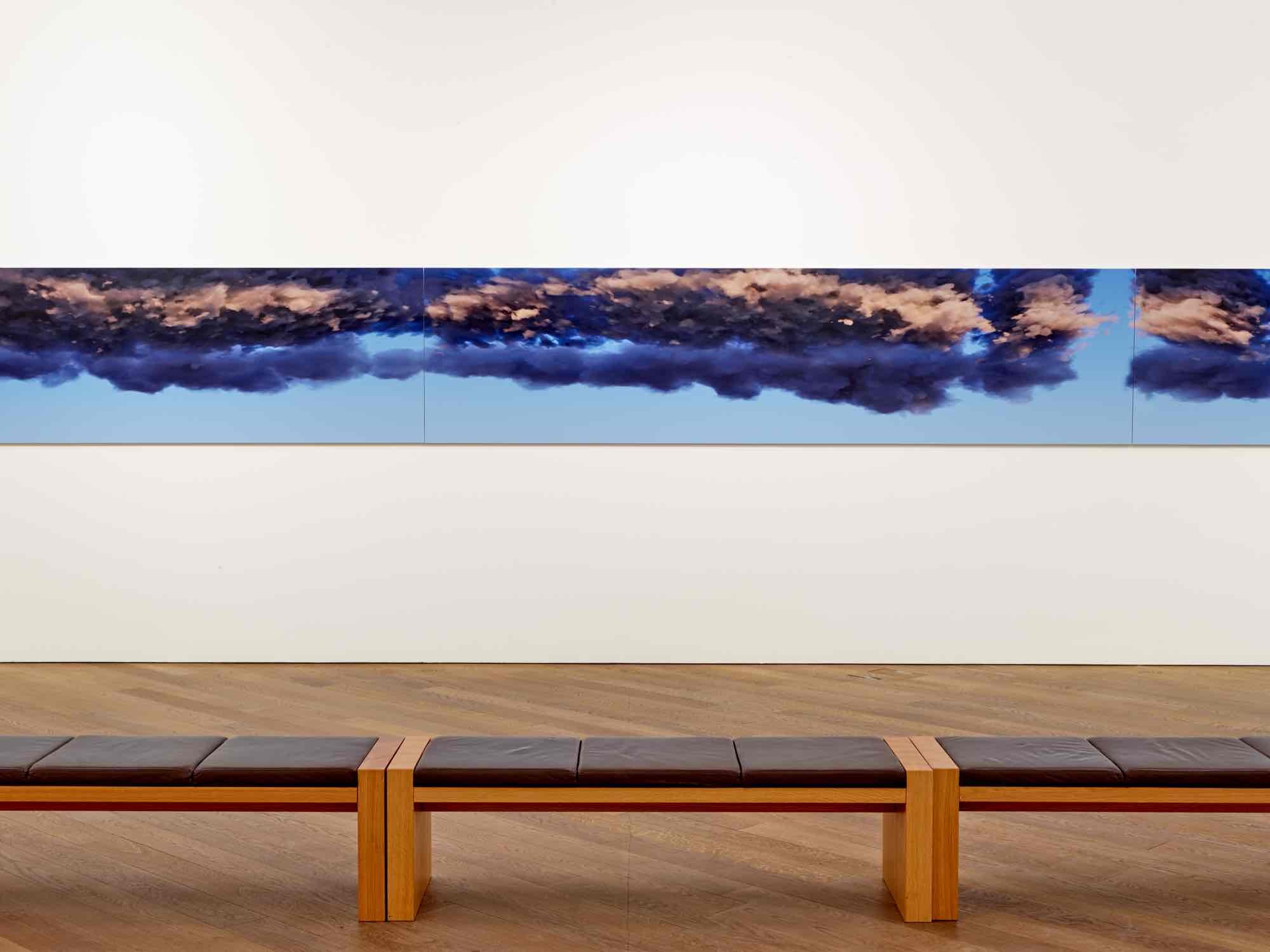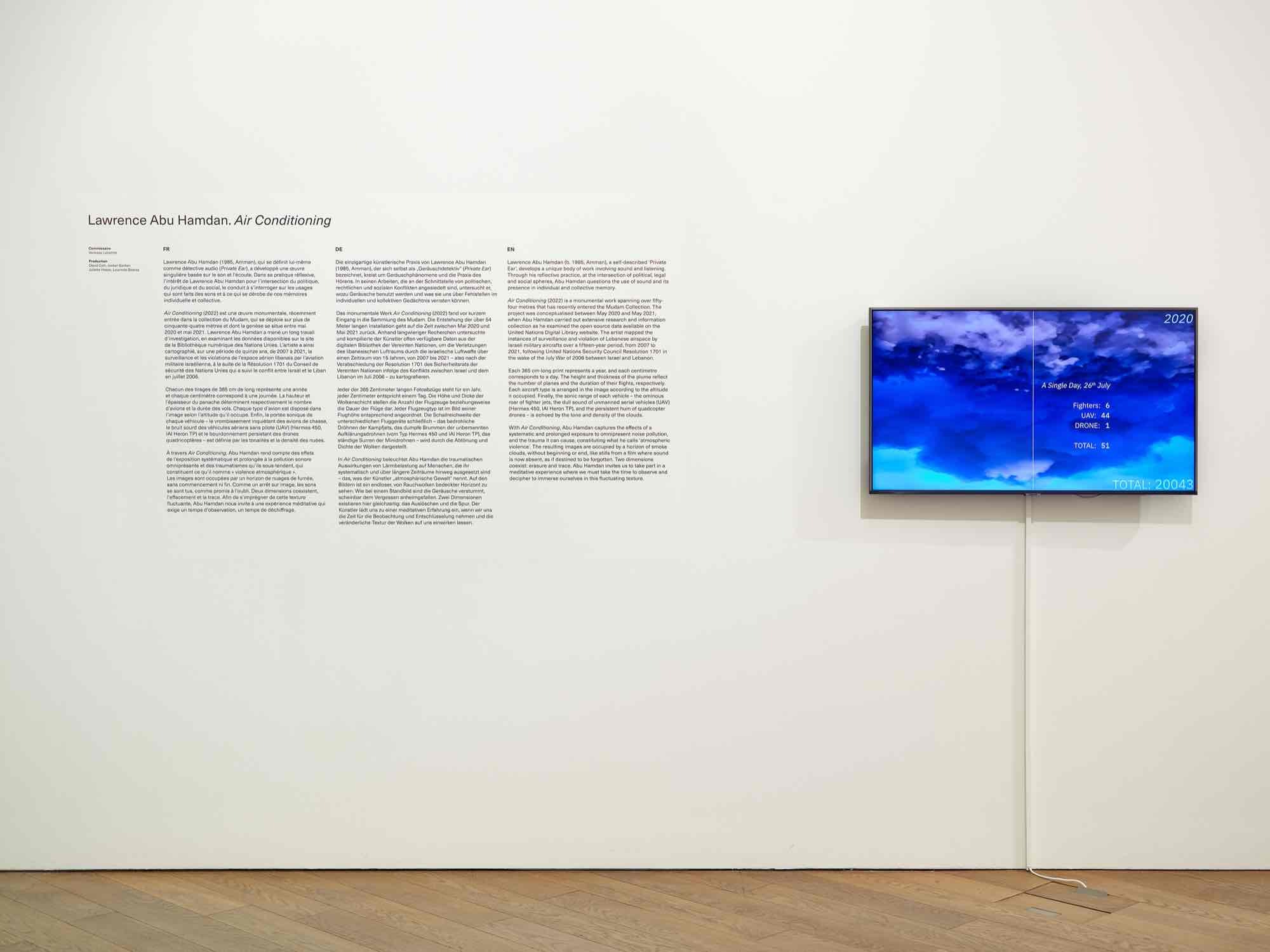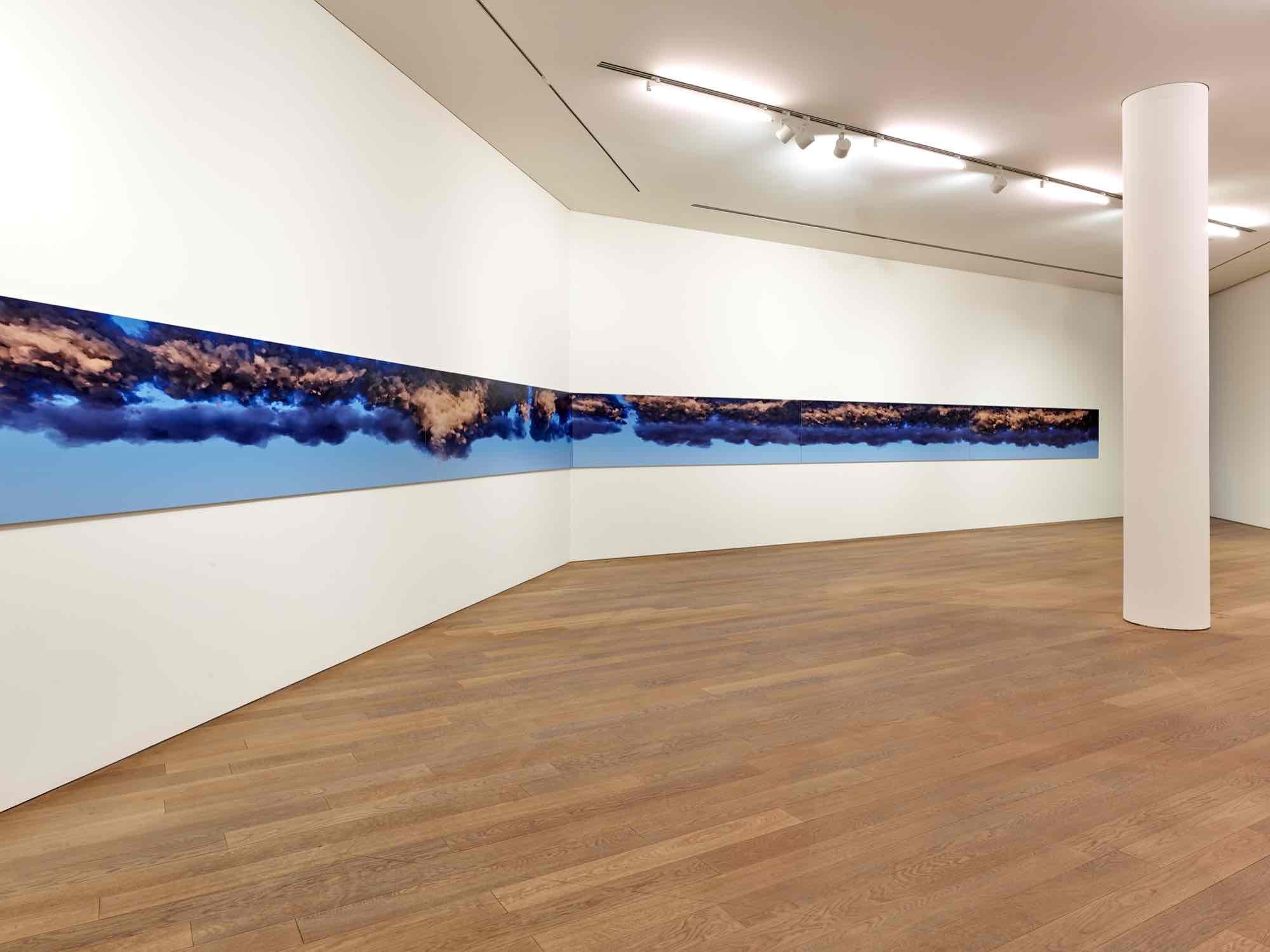Lawrence Abu Hamdan
Air Conditioning
29 Mar - 09 Jun 2024

Lawrence Abu Hamdan, Air Conditioning, 2022 | Collection Mudam Luxembourg | Acquisition 2023
View of the exhibition Lawrence Abu Hamdan. Air Conditioning, 29.03 — 09.06.2024, Mudam Luxembourg
© Photo : Studio Rémi Villaggi
View of the exhibition Lawrence Abu Hamdan. Air Conditioning, 29.03 — 09.06.2024, Mudam Luxembourg
© Photo : Studio Rémi Villaggi

Lawrence Abu Hamdan, Air Conditioning, 2022 | Collection Mudam Luxembourg | Acquisition 2023
View of the exhibition Lawrence Abu Hamdan. Air Conditioning, 29.03 — 09.06.2024, Mudam Luxembourg
© Photo : Studio Rémi Villaggi
View of the exhibition Lawrence Abu Hamdan. Air Conditioning, 29.03 — 09.06.2024, Mudam Luxembourg
© Photo : Studio Rémi Villaggi

Lawrence Abu Hamdan, Air Conditioning, 2022 | Collection Mudam Luxembourg | Acquisition 2023
View of the exhibition Lawrence Abu Hamdan. Air Conditioning, 29.03 — 09.06.2024, Mudam Luxembourg
© Photo : Studio Rémi Villaggi
View of the exhibition Lawrence Abu Hamdan. Air Conditioning, 29.03 — 09.06.2024, Mudam Luxembourg
© Photo : Studio Rémi Villaggi

Lawrence Abu Hamdan, Air Conditioning, 2022 | Collection Mudam Luxembourg | Acquisition 2023
View of the exhibition Lawrence Abu Hamdan. Air Conditioning, 29.03 — 09.06.2024, Mudam Luxembourg
© Photo : Studio Rémi Villaggi
View of the exhibition Lawrence Abu Hamdan. Air Conditioning, 29.03 — 09.06.2024, Mudam Luxembourg
© Photo : Studio Rémi Villaggi

Lawrence Abu Hamdan, Air Conditioning, 2022 | Collection Mudam Luxembourg | Acquisition 2023
View of the exhibition Lawrence Abu Hamdan. Air Conditioning, 29.03 — 09.06.2024, Mudam Luxembourg
© Photo : Studio Rémi Villaggi
View of the exhibition Lawrence Abu Hamdan. Air Conditioning, 29.03 — 09.06.2024, Mudam Luxembourg
© Photo : Studio Rémi Villaggi
Lawrence Abu Hamdan (b. 1985, Amman) is an experimental artist, a researcher- investigator and a self-described ‘Private Ear’ who has developed a unique body of work involving sound and listening, at the junction between photography, performance, writing, video, installation and audiovisual work. Questions of national identity, human rights, justice, and memory are among his recurring themes. Through his reflective practice, at the intersection of political, legal and social spheres, Abu Hamdan questions the use of sound and its presence in individual and collective memory.
Often produced in collaboration with scientists, activists, and linguists, his sound analysis have been presented on several occasions as advocacy for organisations such as Amnesty International (notably with the Forensic Architecture research laboratory) and Defence for Children International, or as evidence in judicial inquiries at the First-tier Tribunal Immigration and Asylum Chamber in the UK.
Air Conditioning (2022) is a monumental work that has recently entered the Mudam Collection. Located on level -1 of Mudam and spanning over fifty-four metres, it wraps the walls of the museum’s East Gallery in silence. This installation is comprised of fifteen photographic panels, produced using a specialised animation software (Houdini), and a looping explanatory video lasting 2 minutes and 42 seconds.
The project was conceptualised between May 2020 and May 2021, when Abu Hamdan carried out extensive research and information collection as he examined the open-source data available on the United Nations Digital Library website. The artist mapped the instances of surveillance and violation of Lebanese airspace by Israeli military aircrafts over a fifteen-year period, from 2007 to 2021, following United Nations Security Council Resolution 1701 in the wake of the July War of 2006 between Israel and Lebanon.
Concurrently, Abu Hamdan developed the website AirPressure.info in an effort to make information pertaining to Israeli incursions accessible through an interactive map (which reveals radar information on overflights – time of day, duration, type of aircraft, and trajectory), a reference library featuring sound and video files of citizen testimonies collected during a participative social media campaign, seventeen scientific articles describing the harmful physical and psychological impacts on the Lebanese population, as well as the 243 letters addressed to the United Nations Security Council.
The artist’s first task was to draw up a documented inventory of the Lebanese soundscape and to render an overview of the sequence and accumulation of over 22,111 events. By aggregating this data, he established that the average overflight duration was four hours and thirty-five minutes. Combined, the total duration of these incursions was 3,098 days, or eight and a half years.
How can we represent the unrepresentable? How can we think of sounds as images and how do we give them form? These are the contradictions Abu Hamdan attempts to resolve.
The resulting images are occupied by a horizon of smoke clouds, without beginning or end, like stills from a film where sound is now absent, as if destined to be forgotten. Two dimensions coexist: erasure and trace. Abu Hamdan invites us to take part in a meditative experience where we must take the time to observe and decipher to immerse ourselves in this fluctuating texture. Fragments of time come and go towards each other, intermingle, expand, and overlap, creating interplays between time and space. Abu Hamdan aims to make the density of time intelligible.
The video provides a preamble. Each 365 cm-long print represents a year, and each centimetre corresponds to a day. The height and thickness of the plume reflect the number of planes and the duration of their flights, respectively. In 2020, for instance, 1,797 unmanned aerial vehicles (UAVs) (Hermes 450, IAI Heron TP) flew over Lebanon. August 2020 was a particularly eventful month: 405 UAVs were recorded flying over the country for a total 2,212 hours. Each aircraft type is arranged in the image according to the altitude it occupied. Finally, the sonic range of each vehicle – the ominous roar of fighter jets, the dull sound of UAVs and the persistent hum of quadcopter drones – is echoed by the tone and density of the clouds.
With Air Conditioning, Abu Hamdan captures the effects of a systematic and prolonged exposure to omnipresent noise pollution, and the trauma it can cause, constituting what he calls ‘atmospheric violence’. Speaking on this, he has said: ‘These images demonstrate the Lebanese atmosphere is a nexus of high pressure in a global weather system. The air is not a sovereign space but a volatile compound; of noise, carbon dioxide, monoxide, nitrogen oxide, sulfur dioxide and all the other toxic emissions of international militarism.’
This investigation has yielded other projects that complement and bring light to each other. The performative reading Daght Jawi (Air Pressure) focuses on one year, as does The diary of a sky (2023) the video installation that stems from it. Using a diaristic form, Abu Hamdan recites the raw data, blending in his research narrative, all of which is illustrated by sequences of images of the Lebanese sky crisscrossed by fighter planes and drones. Playing with the juxtaposition of the breaks and gaps in the speed and intensity of his cadence and breathing, and the deafening noise of the planes, Abu Hamdan renders this constant threat palpable. Illuminating the investigation in the present and the past, in Lebanon and elsewhere, he instils a sensitive memory of sounds.
Abu Hamdan has described his research as a ‘political ecology of noise’. To this end, the aesthetics of inquiry brings forth the noises to which we have ceased paying attention and allow for a reconstruction of narratives that are often excluded from our contemporary histories, both near and far.
Curator Vanessa Lecomte
Often produced in collaboration with scientists, activists, and linguists, his sound analysis have been presented on several occasions as advocacy for organisations such as Amnesty International (notably with the Forensic Architecture research laboratory) and Defence for Children International, or as evidence in judicial inquiries at the First-tier Tribunal Immigration and Asylum Chamber in the UK.
Air Conditioning (2022) is a monumental work that has recently entered the Mudam Collection. Located on level -1 of Mudam and spanning over fifty-four metres, it wraps the walls of the museum’s East Gallery in silence. This installation is comprised of fifteen photographic panels, produced using a specialised animation software (Houdini), and a looping explanatory video lasting 2 minutes and 42 seconds.
The project was conceptualised between May 2020 and May 2021, when Abu Hamdan carried out extensive research and information collection as he examined the open-source data available on the United Nations Digital Library website. The artist mapped the instances of surveillance and violation of Lebanese airspace by Israeli military aircrafts over a fifteen-year period, from 2007 to 2021, following United Nations Security Council Resolution 1701 in the wake of the July War of 2006 between Israel and Lebanon.
Concurrently, Abu Hamdan developed the website AirPressure.info in an effort to make information pertaining to Israeli incursions accessible through an interactive map (which reveals radar information on overflights – time of day, duration, type of aircraft, and trajectory), a reference library featuring sound and video files of citizen testimonies collected during a participative social media campaign, seventeen scientific articles describing the harmful physical and psychological impacts on the Lebanese population, as well as the 243 letters addressed to the United Nations Security Council.
The artist’s first task was to draw up a documented inventory of the Lebanese soundscape and to render an overview of the sequence and accumulation of over 22,111 events. By aggregating this data, he established that the average overflight duration was four hours and thirty-five minutes. Combined, the total duration of these incursions was 3,098 days, or eight and a half years.
How can we represent the unrepresentable? How can we think of sounds as images and how do we give them form? These are the contradictions Abu Hamdan attempts to resolve.
The resulting images are occupied by a horizon of smoke clouds, without beginning or end, like stills from a film where sound is now absent, as if destined to be forgotten. Two dimensions coexist: erasure and trace. Abu Hamdan invites us to take part in a meditative experience where we must take the time to observe and decipher to immerse ourselves in this fluctuating texture. Fragments of time come and go towards each other, intermingle, expand, and overlap, creating interplays between time and space. Abu Hamdan aims to make the density of time intelligible.
The video provides a preamble. Each 365 cm-long print represents a year, and each centimetre corresponds to a day. The height and thickness of the plume reflect the number of planes and the duration of their flights, respectively. In 2020, for instance, 1,797 unmanned aerial vehicles (UAVs) (Hermes 450, IAI Heron TP) flew over Lebanon. August 2020 was a particularly eventful month: 405 UAVs were recorded flying over the country for a total 2,212 hours. Each aircraft type is arranged in the image according to the altitude it occupied. Finally, the sonic range of each vehicle – the ominous roar of fighter jets, the dull sound of UAVs and the persistent hum of quadcopter drones – is echoed by the tone and density of the clouds.
With Air Conditioning, Abu Hamdan captures the effects of a systematic and prolonged exposure to omnipresent noise pollution, and the trauma it can cause, constituting what he calls ‘atmospheric violence’. Speaking on this, he has said: ‘These images demonstrate the Lebanese atmosphere is a nexus of high pressure in a global weather system. The air is not a sovereign space but a volatile compound; of noise, carbon dioxide, monoxide, nitrogen oxide, sulfur dioxide and all the other toxic emissions of international militarism.’
This investigation has yielded other projects that complement and bring light to each other. The performative reading Daght Jawi (Air Pressure) focuses on one year, as does The diary of a sky (2023) the video installation that stems from it. Using a diaristic form, Abu Hamdan recites the raw data, blending in his research narrative, all of which is illustrated by sequences of images of the Lebanese sky crisscrossed by fighter planes and drones. Playing with the juxtaposition of the breaks and gaps in the speed and intensity of his cadence and breathing, and the deafening noise of the planes, Abu Hamdan renders this constant threat palpable. Illuminating the investigation in the present and the past, in Lebanon and elsewhere, he instils a sensitive memory of sounds.
Abu Hamdan has described his research as a ‘political ecology of noise’. To this end, the aesthetics of inquiry brings forth the noises to which we have ceased paying attention and allow for a reconstruction of narratives that are often excluded from our contemporary histories, both near and far.
Curator Vanessa Lecomte
